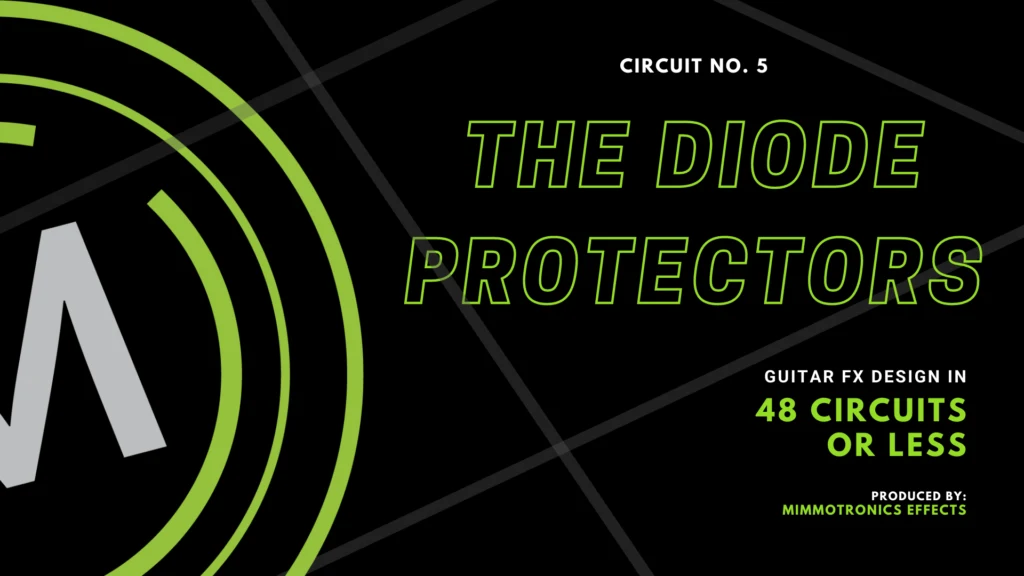
Have you ever plugged in the wrong polarity power supply? If the circuit was never designed with that in mind, you probably weren’t too happy with the outcome! Chips can get fried, capacitors can blow up, and magic smoke may appear from strange places. Mitigate the damage done to your precious guitar effect designs by employing a reverse polarity protection circuit.
[Last Updated: January 6, 2024]
As a member of the Reverb Partner Program and as an Amazon Associate, StompboxElectronics earns from, and is supported by, qualifying purchases.
Disclaimer: Stompbox Electronics and/or the author of this article is/are not responsible for any mishaps that occur as a result of applying this content.
The Diode
The center component to reverse polarity protection is the diode. Diodes are electronic components built with semiconductor material (usually germanium or silicon). They have two leads: an anode and a cathode. Manufacturers usually mark the cathode with a silk-screened line on the component body, shown in Figure 5.1.
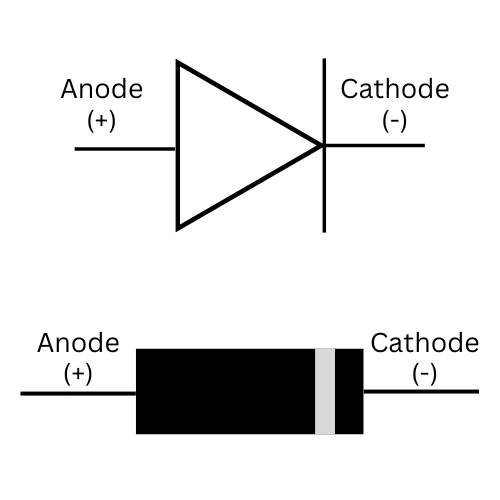
Diode Current Flow
Current can only flow through a diode in one direction: from the anode (+) terminal to the cathode (-) terminal. The schematic symbol for a diode looks like an arrow pointing in the directly of “allowed” current flow, shown in Figure 5.1.
For me, it’s always been difficult to remember which side is the anode or cathode. The way I remember is that the word “anode” starts with the letter “A”. The schematic symbol for the diode includes a triangle on one side, which kind of looks like the top of the letter “A”. Therefore, the anode is on the triangle side.
If that doesn’t work for you, then consider this: the negative side of the diode is usually marked with a line. Since a subtraction symbol is basically a line, you can remember that this side of the diode is meant to be the “negative” side of the diode.
Forward Voltage Drop
One key characteristic of diodes is their forward voltage drop. This voltage drop can be measured across the diode with a multimeter set for voltage mode. In Figure 5.2 (below) the voltage Vdiode depicts the voltage drop across the diode, equal to about 650mV in this case.
The forward voltage drop is a standard value that is characteristic of all diodes. For silicon diodes, the rule-of-thumb value is typically 0.65V. For germanium diodes, use 0.3V.
- Silicon Diode Voltage Drop = 0.65V
- Germanium Diode Voltage Drop = 0.3V
Note that these are “rule-of-thumb” values, meaning they vary between each individual diode. Go ahead and test it for yourself! If you have an assortment of diodes you can measure each one individually. You’ll most likely find that they average around the rule-of-thumb values above.
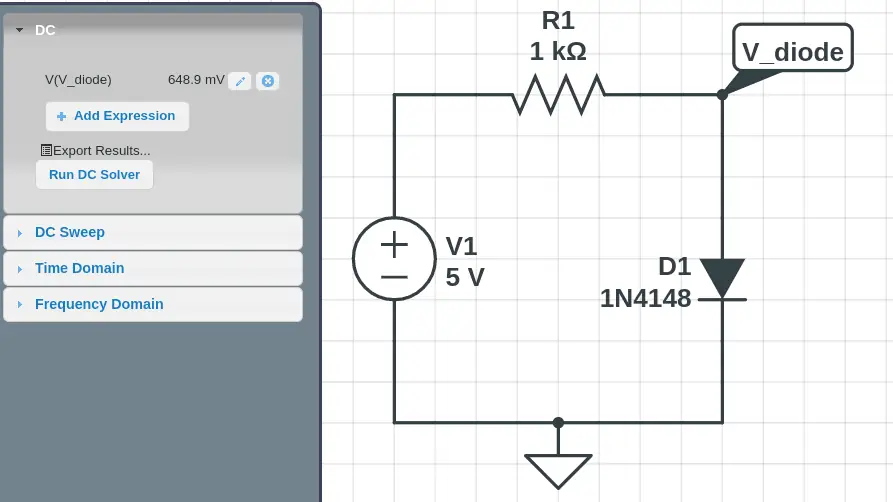
Reverse Polarity Protection Using a Series Diode
Most pedals are set up with negative-tip polarity. This means that the center pin in the power connector connects to ground, while the outer barrel connects to the positive supply voltage rail.
While negative-tip polarity is a widely adopted standard, some pedals are built with positive-tip polarity. There is always the potential of somebody powering the pedal with the wrong polarity power supply, causing all sorts of failures to occur.
Reverse polarity protection is the act of protecting your circuit from a power supply with an improper polarity – and the diode is a great candidate for this task. It only allows current flow in one direction, so let’s put it in series with the effect circuit as shown in Figure 5.3.
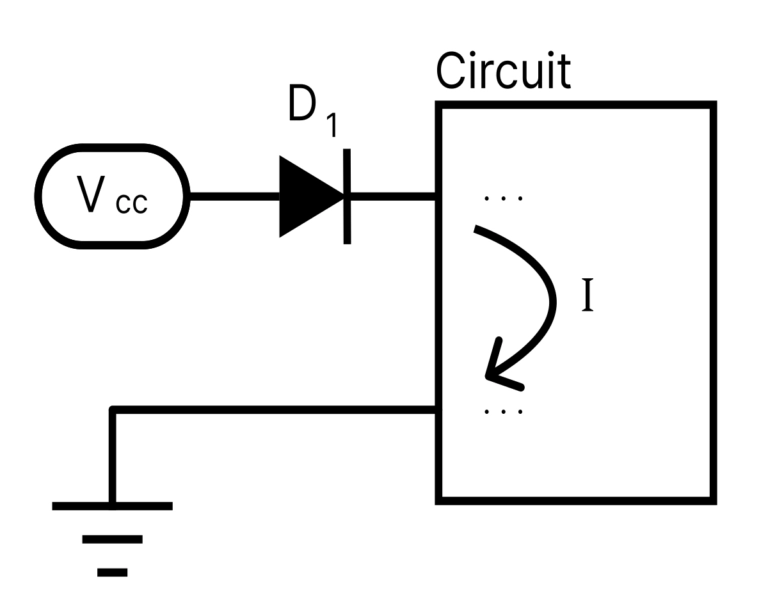
You can spot this style of polarity protection in tons of guitar pedal designs. The BOSS compact series is one example, especially during the two-decade-long era of using ACA power supplies.
Problems with the Series Diode Arrangement
There is one setback for using the series diode configuration: the Forward Voltage Drop.
Let’s say your input voltage is 9V and you use a silicon diode. The circuit only receives 8.35V (9V minus 0.65V). This is unfortunate, because most DIY circuits you’ll find online are designed with 9V in mind. Depending on the circuit, this could result in biasing problems at worst. At best, it may reduce headroom.
There is an arrangement that circumvents this technical issue: the parallel diode arrangement.
Reverse Polarity Protection Using a Parallel Diode
So the series diode arrangement had a voltage sag issue. Let’s see if we can fix it with a parallel diode arrangement. The anode (+) connects to the negative terminal of the power supply while the cathode (-) connects to the positive terminal. This is depicted on the left side of Figure 5.4 below.
With the parallel arrangement no current flows through the diode during normal pedal operation. The circuit utilizes the full supply voltage VCC.
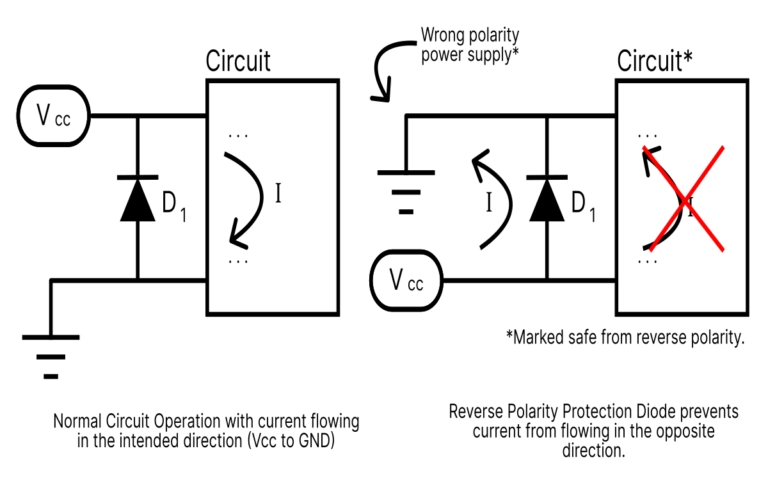
When a power supply with the wrong polarity is plugged in the diode springs to action (Figure 5.4, right). All of the current diverts through the diode instead of the circuit, thus protecting the circuit from negative voltages.
Problems with the Parallel Diode Arrangement
The parallel diode arrangement fixed the voltage sag issue that we experienced with the series diode. We can now expect that the full voltage range of our power supply will reach the effects circuit.
Upon failure, all of the current rushing through the diode can generate heat. As a result, the diode burns up and fails. This is great news, as the whole reason we installed a parallel protection diode was so it could be sacrified.
The downside is that a problem like this usually renders the pedal inoperable until it can be seen by a repair tech. It’s a very common issue I’ve seen on many guitar pedal repair jobs, and it usually manifests with the pedal not being able to turn on.
Thankfully it’s usually a simple fix: replace the parallel protection diode.
Other Approaches to Power Supply Protection
For reverse polarity protection, series and parallel diode configurations do the job well enough. You can even use a combination of them, in the case that the voltage sag from the series arrangement isn’t a major design issue. See Figure 5.5 for a series/parallel combo approach:
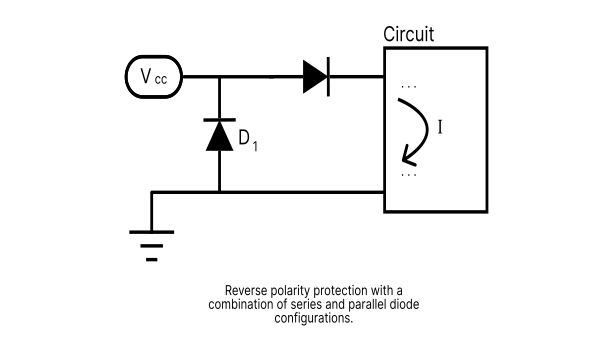
If you are looking to protect against an AC supply, the diode circuits on this page won’t help. There are a few circuits that can help, but they involve more advanced approaches and are out of the scope of this series. See the Resources section below for more information.
Reverse Polarity Protection Parts List
You can build the reverse polarity protection circuit with just 1 part: a diode! Preferably a rectifier diode from the 1N400x series. The 1N4001 is a good choice for guitar pedal designs. It can withstand up to 50V in the reverse polarity direction, which is more than enough.
| Parts | Qty |
|---|---|
| 1N4001 Diode | 1 |
Resources
[1] A cheap – and good – polarity protector, Geofex, R.G. Keen (c)2004
[2] Advanced Power Switching and Polarity Protection for Effects, Geofex, R.G. Keen (c)1999
Guitar Effects Design in 48 Circuits or Less
The 48 Circuits or Less article series serves to close the gap between DIY guitar effects design and guitarists interested in the craft by uniquely curating the most important aspects of DIY guitar effect circuit design. This post is part of the 48 Circuits or Less series. View more articles in this series here.
Meet the Author:

Hi, I’m Dominic. By day, I’m an engineer. By night, I repair and modify guitar effects! Since 2017, I’ve been independently modifying and repairing guitar effects and audio equipment under Mimmotronics Effects in Western New York. After coming out with a series of guitar effects development boards, I decided the next step is to support that community through content on what I’ve learned through the years. Writing about electronics gives me great joy, particularly because I love seeing what others do with the knowledge they gain about guitar effects and audio circuits. Feel free to reach out using the contact form!
The Tools I Use
As a member of Amazon Associates, Stompbox Electronics earns and is supported by qualifying purchases.














